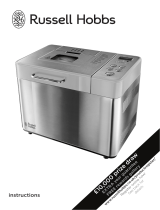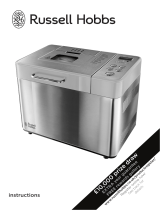
11
C POWER CUTS
1 If you suffer from a power cut lasting less than 7 minutes, the breadmaker will carry on when
power is restored, and the program time will be extended by the duration of the power cut.
2 If the power cut is more than 7 minutes, the program will fail – unplug the breadmaker, let it
cool down, then empty the loaf tin, dispose of the ingredients, clean it, and start again.
3 This also works if you unplug the breadmaker or switch it off accidentally.
, Make sure you remove the paddles before you dispose of the ingredients.
C ERROR MESSAGES
1 If the breadmaker is too hot, the display will show an error message – an odd set of letters
and/or numbers.
2 If this happens, press the start/stop button for 2 seconds, remove the loaf tin, and let the
breadmaker reach room temperature before trying again.
3 If this doesn’t work, then the problem isn’t overheating, it’s probably broken.
C CARE AND MAINTENANCE
1 Unplug the breadmaker (switch the socket off first, if it’s switchable).
2 Open the lid, and let it cool down fully before cleaning.
3 If the paddle has stuck to its shaft, fill the loaf tin with warm water. This should soften any
dough residues and allow the paddle to be removed. Don’t leave it to soak.
4 If the inside of the paddle gets clogged with flour, soak it in warm water, then dig out the
flour with a wooden cocktail stick.
5 Wash the loaf tin and paddle in warm soapy water, rinse, then dry thoroughly.
6 Wipe all other surfaces, internal and external, with a damp cloth. Use a little washing-up
liquid if necessary, but be sure to clean it all off, otherwise it might taint the next lot of bread.
7 Make sure everything is dry before reusing the breadmaker or storing it away.
8 Don’t immerse the breadmaker in water or any other liquid.
9 Don’t use harsh or abrasive cleaners or solvents.
10 You may wash the loaf tin and paddles in a dishwasher, but we don’t recommend this, as the
harsh environment inside the dishwasher may affect the surface finishes. If you do, then you
must put the paddle, on its own, in a compartment of the cutlery basket.
C RECIPES
1 Many external factors affect the taste and texture of your bread (e.g. yeast type, flour type,
sugar type, kitchen temperature, even air pressure and height above sea level).
2 The recipes supplied have been designed specially for this breadmaker.
3 If you want to experiment, use the recipes as a guide, but vary the ingredients, vary the
quantities, taste the results. Keep notes, write down what changes you make, and you’ll build
up a range of recipes which suit your taste. Keep notes of the not-so-successful ones too, so
you know what not to do next time.
4 You’ll find it’s best to change only one ingredient at a time – if you change more than one,
you won’t know which one was responsible for the effect you got.
5 If you already have bread recipes, or find recipes in other publications, compare them with
the recipes given here, to find out which program to try first, then experiment till the results
match your desires.
5 Be careful with quantities when using other recipes. For the first trial, don’t fill the loaf tin
above about a quarter full, certainly not as much as a third full. If you overfill it, the rising
bread may push the lid off. That’s on a good day. On a bad day, it’ll spill over the side, burn on
to the element and clog the drive.
C USING THE RECIPES
1 Tablespoons (tbsp) are 15ml, teaspoons (tsp) are 5ml.
2 Spoons should be level, not heaped.






















